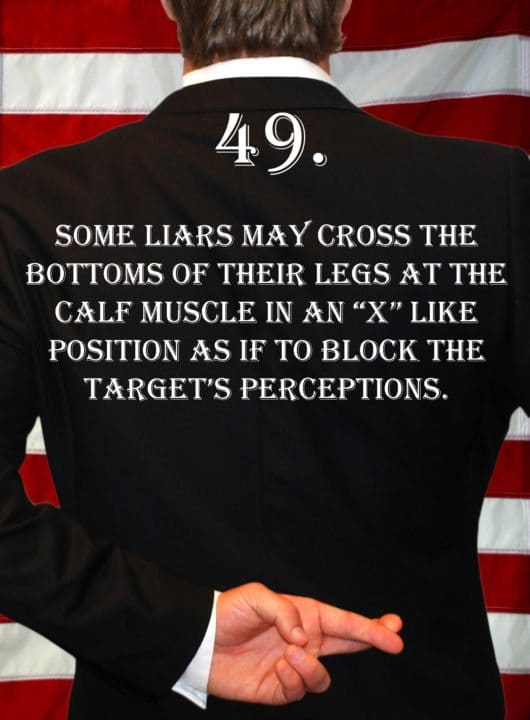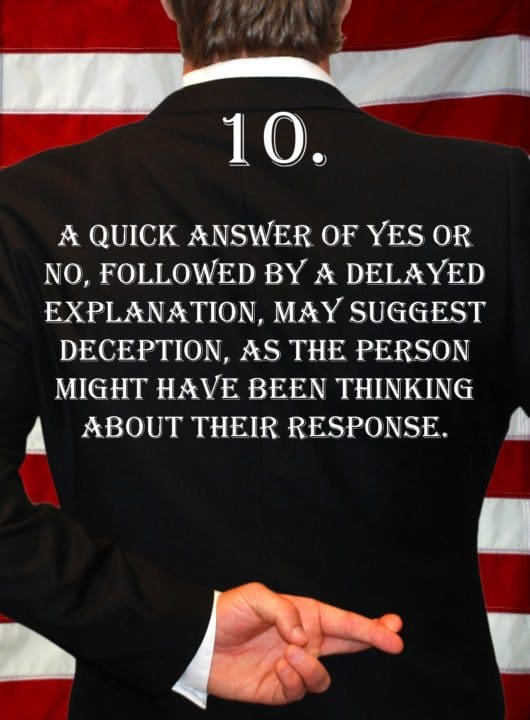
Deception Tip 51:
People under stress or tension will wring their hands or tightly clasp them together.
Listen To The Podcast!
E51 – Wringing Hands – Deception Tips Podcast – Click Here To Subscribe
Podcast Transcript
Hello and welcome to the deception tips podcast where you will learn amazing cues to detect deceit that will help you read people like never before, I’m your host Spencer Coffman, let’s get started.
Welcome to episode 51 of the deception tips podcast, we’ve got a hundred and one episodes in total, so we are about halfway home. I hope that you are getting a lot out of these podcasts, please remember to check out the deception tips book, check out the deception tips revised and expanded book, also, a guide to deception.
All of those are some excellent resources for you to continue to learn more about how to read people and detect deception so you will know when someone is lying to you.
Also remember that there are videos that I’ve done and they’re on YouTube, it’s called the body language YouTube channel and they are all about deception. Each podcast is about a single tip, same way, each video is about a single tip.
You’re going to have a hundred one videos that match these podcasts, in the future sometime, we’re going to put all of those videos into a podcast so you can listen to them as well without having to watch them, for example, if you’re driving or something.
We’ve got tons of resources for you, take advantage of each and every one of them and always feel free to reach out, contact me, put a comment on something, send me a message on social media, whatever the case may be.
I’ve got a lot of stuff on LinkedIn, I also have the deception tips website, so there are all kinds of stuff. Feel free to contact me with any questions you may have, I’m always here to help you out and I will continue to give you more and more information about how to read people and detect deception.
Last time, we talked about a certain sign that was an entire body sign, it was when someone really isn’t happy in the current situation. They’re not enjoying themselves there, they want to get out, they want to leave, they don’t like whatever’s going on. This could mean that they’re bored, could mean that they’ve just had enough, and it could mean that they’re not getting anything from the conversation.
The situation is a waste of time in their eyes, so they don’t want to be there anymore. This was when we talked about how someone faces toward the exit, they either can angle their shoulders there, for example, when you square up your shoulders with somebody, you’re either really engaged with them or you’re about to fight or something like that.
You watch animals in a cage or people in prison, put a person in a cage they start to behave like an animal, I’m a firm believer in that. That’s not saying we shouldn’t put people in prison, don’t even go there, that’s a whole other side of this but you put someone in a cage, they behave like an animal. So, if you watch TV of people in prison when they start to square up, they’re going to fight, they’re locked on, they’re engaged.
You watch two people who are in love, they’re squared up with each other, they’re locked on, they’re in love, they’re engaged, it’s a certain term right there. So, when someone faces their shoulders to something, they’re locked on. You go skiing, you’re down the slope, if your shoulders are not going down the slope, you are going down the slope into the snow.
So, if someone is facing towards the exit with their shoulders, maybe their legs are pointed to the people, but the shoulders are turned, boom, they want out. In the same way, if their legs are squared up to the exit, so their hips or where their knees are if they’re sitting down if their knees are pointed towards the exit, and maybe their shoulders or their torso is engaged with the person, they still want to leave.
However, you know for a fact that they really, absolutely want to leave if their shoulders and their knees are both facing towards the exit, it’s time to go, they want out immediately.
It is up to you whether you’re going to use that to your advantage, for example, if you are interrogating them, maybe you see that discomfort and you poke and prod at it and make them even more uncomfortable until they give you what you want or tell you what you want to know.
If it’s a friendly conversation, maybe you see that discomfort and you decide to take a break for a while or you do something else or change the topic, whatever that case may be. However, keep in mind that when someone is facing towards the exit instead of towards the conversation and towards the situation, generally, they would like to leave. They may not consciously know it, but they unconsciously do not want to be in that situation.
Today, we have another great sign of deception for you, it’s more about stress and tension. We’ve hit this a lot throughout these podcast episodes, stress and tension are super prevalent in lying. It is something that you will really never avoid when telling a lie.
That’s how lie detectors work, they prey upon that stress and tension, they monitor all of your body signs, your heart rate, your sweat, all that stuff and they see that when people lie, there’s a spike in that behavior.
Now, that spike means that the stress or tension involved, their neurological stress, and tension fired, which means that when we lie, we have scientific evidence that we are under more stress.
This is why certain things have lie detectors, you can beat the lie detector if you put a thumbtack in your shoe, and then you step on it every time you tell the truth, that way there’s a little spike on there for pain stress then when you tell a lie, you don’t step on it and that way the spikes even out.
Of course, this may or may not work, I wouldn’t recommend trying it but it’s a theory that goes along with it when dealing with the stress spike. So, we’ve already established throughout all these episodes that when people tell lies they are under a tremendous amount of stress and tension and that is what we are going to talk about today.
So, here it is, this is a deception tip number 51. People under stress or tension will wring their hands or tightly clasp them together. Here it is again, people under stress or tension will wring their hands or tightly clasp them together.
Now, obviously, people under stress and tension will do more than just wring their hands. In addition, some people under stress and tension may not wring their hands, so it’s always, like anything, a very confusing or somewhat convoluted sign.
Remember that any single sign is never enough for you to make a conclusion, remember how many times I’ve told you this, it’s over and over again. You already know what I’m going to say, look for patterns and clusters of behaviors, you can never look for a single sign.
The day that you look for a single sign and make a conclusion is the day that you will be wrong, and you will really regret it, most likely you will regret it.
You know what, you may not be wrong but if you make it a practice, you definitely will be wrong eventually. Look for patterns and clusters of behavior, it is very important. In this sign, wringing the hands, wringing hands is a sign of stress or tension, it’s a sign of stress or tension release. In the same way, we’ve talked about different signs in the past and I’ll refresh your memory on those coming up right after this.
Want to be a human lie detector but don’t have the brains or the guts to do it? We understand that’s why we created the Deception Tips blog, especially for you. Check it out today on spencercoffman.com.
Welcome back to deception tip 51, once again we are talking about how liars are under a tremendous amount of stress and tension when they tell a lie. Specifically, today, we’re talking about a sign of that or an outward display of this stress or tension release.
This is almost like a pacification gesture, they’re pacifying the stress and tension. We are talking about how people will wring their hands when they are stressed and tense.
Before we went to the break, I promised that I would refresh your memory on all the other podcast episodes we’ve talked about when we had someone under certain stress or tension.
So, I’m going to hit every one of them and some of them may seem a little far-fetched but I’m going to bring them around. So, right off the bat in episode number one, we talked about folding the arms.
You may say, “Wait a minute, folding the arms, that was a defensive behavior, withholding, but can it also be stress and tension?” Yes, depending on how much pressure they’re putting on that arm fold. You can fold your arms and try to pull your arms apart and really push on them and when you’re done, you can look, and you’ll have marks like on your elbows and on your hands and stuff.
That’s because you really put a lot of pressure on there, that was some release of stress and tension. So, that’s another possibility that could be a stress and tension behavior but that’s up to you to determine that when looking at the person to see if you see those pressure points there. Are their hands white or is their skin turning white or red, etc.?
So, we’ve also had some other signs of stress and tension, specifically things like locked ankles. That’s one where they can lock up their ankles and they can really push on it and the stress and tension can be showing out there, locked ankles, that was in episode 22 in case you want to jump back to that one.
Bouncing both legs is in number 30 and that’s when someone is bouncing one leg up and down, ding, ding, ding, ding. It can be annoying or something if you’re sitting next to them in the church pew and you’re getting vibrated by them, but that’s beside the fact, what does that mean?
Well, it’s usually like nervousness or some type of a deal but it’s also stress and tension, it’s a pacification gesture, they’re releasing that stress and tension that’s built up inside of them.
When you see both legs going, now you know it’s really some stress and tension, so that’s another one that you got to watch out for. Tense neck, when people tense up their neck and you can see those veins protrude, that is some stress and tension you can see. It’s just like this one where wringing the hands, you can really see that one coming through just like the tense neck and that one is episode number 38.
Now, we’re going to jump to episode number 42 with the back of the neck. Remember with the back of the neck, they can massage away the tension in telling a lie so that one is again a stress and tension behavior, it’s also one that people will say it’s a comforting gesture because it’s massaging.
Anytime you get a massage it feels good unless you’re really getting a deep tissue massage then they might be really cranking on you and it could cause a little pain but later it feels nice.
So, remember all of these, there’s a lot of stress and tension, pretty much anytime you see somebody massage themselves, that’s a stress or tension release.
For example, in number 51 today, how we’re talking about wringing hands, which is in a way a form of massage. They might be massaging their palms with a thumb, massaging one palm or they might be massaging the other palm, which could still count as a wringing of the hands gesture.
However, in the typical scenario, it’s almost like the steeping of fingers but they fold their hands. So, it’s like they’re clasping, and they may be squeezing one hand and then the other or turning them side to side almost like they’ve got something in their hands that they’re trying to grind into dust.
They’ve got a little stone in there and they’re just pulverizing that stone or when people put lotion on their hands, and they rub them around and around and back together, that’s the kind of behavior you’re looking for.
What does it mean? Well, it could mean that they have lotion and they’re rubbing lotion into their hands, so keep in mind that it does not always mean stress or tension. However, if you observe that they didn’t put any lotion on, they don’t have any rock or anything in their hand that they’re pulverizing then it’s a very good possibility that it might be some stress or tension release.
In that case, look for patterns and clusters of behavior, look for those other signs that we went through. Did they bounce their legs, have they folded their arms, have they locked their ankles, have they pushed on something, have they massage their neck? Are they rubbing their temples?
That’s one that we haven’t talked about at all, but you see that in movies when they’re stressed, they put their head in their hands, they put it on their temples, they massage their temples, those kinds of things.
If you see other behaviors that are indicative of someone who’s a little bit stressed out or overwhelmed and then all of a sudden, you’re seeing the wringing of the hands, now you know that the stress and tension are there.
From there, it’s up to you what you’re going to do with that. If you’re in a situation where you’re trying to find the truth and you’re questioning somebody, the stress and tension might be good.
Maybe by putting them under a little stress and tension, you are forcing them to be uncomfortable, which means that they may let the truth slip. They’re not as comfortable in their environment so they’re not going to be secure in telling that lie.
However, if this is your good friend and you are talking to them, you’re counseling them through past trauma or something and you see the stress and tension, maybe it’s time to take a break and come back to it.
Maybe you switch the topic for their benefit but if you’re trying to find the truth, you may want to push it a little further. In addition, if you’re in some kind of business negotiation, maybe that stress and tension can tell you that this person is really nervous about this deal, something’s wrong, what aren’t they telling me?
They’re trying to sell their company, they’re wringing their hands, do they not want to sell the company or is there something wrong with their company that they’re trying to hide from me and I’m about to find out and that’s why they’re getting a little stressed and tense about it.
So, like anything, you need to determine the environment and understand the entire situation and then continue to look for those patterns and clusters of behavior so that you know what these behaviors mean and when they are occurring. Pay attention to all of that and you will be much better off than if you just look for a single deceptive behavior or a single sign.
I want to thank you for listening to the deception tips podcast, I hope that you’ll share it with your friends, subscribe to the feed, check out the deception tips videos, the blog, and take a look at the books I have available and as always, tune in next week for a new deception tip.
Video Transcript
Hey guys, my name is Spencer Coffman, thank you for watching the deception tips videos they’re all about teaching you how to read people and detect deception so that you will be able to tell if someone is lying to you. Today we are going to talk about a very special tip, this is a pacification gesture, it’s also a stress releasing or tension releasing gesture.
Remember, when someone is telling a lie they are completely stressed and tense, we’ve talked about this before and we’re going to talk about it again because it’s very important. They are lying about whatever it is they did, or they are getting out of or covering up or whatever, so they’re stressed about the lie.
They have to remember what to say whether they have invented something or they’re leaving out details, they need to remember that. It’s an entire process in their mind that is unnatural, it’s because they didn’t live it, it didn’t happen, so that means they have to invent something or remember something false which is more work, they’re memorizing something.
If they’re really good at memorization maybe, it’s easier but there is still some stress and tension there then they’re stressed about a number of things. They’re stressed about whatever they did and the consequence of it, they’re stressed because they know they’re not supposed to tell a lie so it’s morally stressing. They’re stressed about lying to that person and selling their lie to them making them believe the lie.
They’re also stressed about getting caught and whatever the consequence is about whatever they’re covering up. In addition, if they get caught now there is the consequence of lying on top of that, so it’s a whole slew of things that’s just like a big snowball. It’s one thing after another, if you give a mouse a cookie then they want this and all down the row it’s just like that.
There’s a ton of things that are building and building and building so when that’s happening the liar can become overwhelmed and then you’re going to start seeing these stress and tension releasing gestures. We’ve talked about a number of them before and we’re going to talk about another one today,
So, here it is, this is deception tip number 51. People under stress or tension will wring their hands or tightly clasp them together. So, what does that look like? Well, if you’ve ever seen somebody wring out a washcloth, they’re wringing out that towel or that wet thing to wring out and get all the water out of it, wringing the hands is very similar. You may see them fold their hands and then wring them back and forth and they’re squeezing one hand and then the other.
They’re working like they have a piece of clay in there, so you may see them fold their hands this way and then wring them back and forth. There may or may not be a lot of pressure there, maybe it’s just nice and casual or fidgets back and forth but it’s stress or tension. As you see me do this you’re watching like man, what’s the deal with that guy, why are his hands going like that, he looks kind of nervous.
If you were to watch that section without audio or show that to someone, do that, it’s a little experiment. Get somebody who’s around, whether it’s a roommate, a sibling, a parent, coworker, and cue up that little 15 seconds where I was talking with my hands and then I started going like a crazy person. Have them watch that and say hey, what do you think this person is feeling?
They’re going to tell you well, he looks really nervous or he’s unsure or something’s wrong or something like that, they have some kind of a problem. It’s because they do, it’s a nervousness gesture, it’s something that happens when someone is trying to pacify that stress and tension. There’s a key word right there, pacify, it is a pacification gesture, we’ve talked about these before.
We’ve talked about bouncing the legs or folding the arms or pursed lips and exhaling through them and different things like that. Whether it’s locking the ankles or any of those pacification gestures that are done to pacify that stress and tension involved in telling the lie. So, keep that in mind that when you see somebody wringing their hands or tightly clasping them this is done to release that stress or tension that they’re feeling, and they’re overwhelmed with that lie.
They’re doing that, they’re going to calm down a little bit, you’re going to also see different signs with that, so other patterns and clusters of behavior whether it’s breathing or something else whether it’s a different pacification gesture, so keep an eye out for all of those as well.
If this is your first time watching these videos, I’d love to have you subscribe to the channel on YouTube, feel free to comment with any questions you may have as well. Also, if you’d like more information, we have books, blog posts, podcasts, all available on spencercoffman.com that are dedicated to teaching you exactly what every body is saying.
Until next time.






